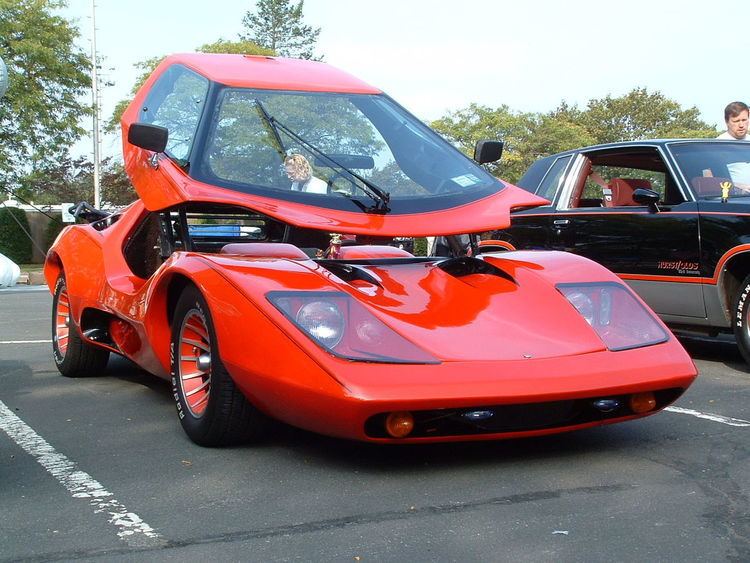 | ||
A vehicle canopy is a rarely used type of door for cars. It has no official name so it is also known as an articulated canopy, bubble canopy, cockpit canopy, canopy door, or simply a canopy. A canopy is a type of door which sits on top of a car and lifts up in some way, to provide access for passengers. It is similar to an aircraft canopy. There are no established sub-types of canopies, so they can be hinged at the front, side, or back, although hinging at the front is most common. Canopy doors are rarely used on production cars, and are sometimes used on concept cars.
Contents
- Advantages
- Disadvantages
- Cars that use canopies
- Messerschmitts
- 1953 Messerschmitt KR175
- 1956 Messerschmitt KR200
- 1970 Ferrari Modulo concept car
- 1970 Bond Bug
- 1971 Nova kit car
- 1985 Buick Wildcat concept car
- 2002 Volkswagen 1 litre car
- 2005 Maserati Birdcage 75th concept car
- 2006 Saab Aero X concept car
- Batmobile
- Custom cars
- Lamborghini
- Holden
- References
Advantages
Disadvantages
Cars that use canopies
This is not a full list of cars that use canopies, but just a few examples.
Messerschmitts
Messerschmitt, the notable German aeroplane manufacturer, weren't allowed to produce aircraft after World War II. Instead, they produced cars. These were designed by the aircraft engineer Fritz Fend. A vehicle canopy was a new concept that is believed to be invented by Messerschmitt; this originated from their aircraft design. They quickly adopted the canopy as this was a simple solution that they had experience in. Unlike most car canopies, the Messerschmitt canopies are hinged on the side, as was the canopy of their famous Bf 109 fighter (as was common with numerous other pre-war and wartime fighter designs). A problem with side hinging, is that for a car with normal side-by-side seating arrangement, the passengers sitting closest to the hinge will have to climb across the outer seat to get out of the car. For that reason the side-hinging canopy is best suited for single-occupant or tandem-seat cars, and after this, canopies were usually hinged at the front or back.
1953 Messerschmitt KR175
The KR175 was the first car, production or concept, to have a canopy. In 1956, the model was changed to the Messerschmitt KR200.
1956 Messerschmitt KR200
The most noticeable thing about the KR200 is its distinctive bubble canopy, which gave rise to the term 'bubble car'. The KR200 continued Messerschmitt's side-hinged canopies. These were usually transparent acrylic ("Plexiglas" or "Perspex"), though reproductions are car-safe polymethyl methacrylate.
1970 Ferrari Modulo concept car
Only one unit of the Ferrari 512 S Modulo was built, to a design by Pininfarina.
1970 Bond Bug
The Bond Bug is a small 3-wheeled sports car and was the first production car to use a front-hinged canopy.
1971 Nova kit car
Other than the Purvis Eureka (a licensed copy of the Nova) and the Bond Bug, the Nova is the only production car to date to use a front-hinged canopy door. The windscreen has small A-pillars so it looks like a conventional car when the canopy is closed.
1985 Buick Wildcat concept car
The 1985 Buick Wildcat concept car had a canopy. The style of canopy it used is an extended canopy, as it is composed of much of the front bodywork, and not just the passenger compartment. A canopy was used in this concept car as it was thought to be futuristic.
2002 Volkswagen 1-litre car
The concept Volkswagen 1-litre car, VW 1L, uses a canopy door. The 2013 production version of this concept used butterfly doors.
2005 Maserati Birdcage 75th concept car
The Maserati Birdcage 75th lacks conventional doors, instead, it uses an extended canopy system. The demonstrator model lacks air-conditioning and so journalists (including Evo Magazine's Harry Metcalfe) experienced the previously-mentioned 'glasshouse effect': whilst driving the vehicle they were reportedly forced to keep the bubble slightly open on hot days to cool the car's interior.
2006 Saab Aero-X concept car
The Aero X's top canopy is styled on the one of the Saab aeroplanes, and this was their inspiration for using a canopy. The canopy opens by remote control, and there is a lever to close it again.
The three-piece canopy eliminates the problems like a high sill and awkwardly angled roof, although the mechanisms are more complex and so heavier, and more likely to fail; leaving an occupant stranded inside a car. The canopy includes a wrap-around windscreen and a glass roof, side windows and body panels (which lift upwards, lowering the sills), and the top roof section of the interior fascia (which moves inwards so it doesn't obstruct entry/exit). These sections intricately manoeuvre themselves into a position where they take up as little space as possible. This construction eliminates the need for doors and A-pillars and so the windscreen extends from B-pillar to B-pillar, which has the important benefit of improving overall visibility.
Batmobile
Various models of the Batmobile used in the production of the Batman films make use of the canopy door.
Custom cars
Bubble canopies are popular on some custom cars, most notably those by Ed Roth, such as the Orbitron, Road Agent and Beatnik Bandit.
Lamborghini
Lamborghini Egoista, the company's 50th anniversary celebration car, has this kind of door. It is designed to look like a fighter jet.
Holden
Holden Hurricane, a concept car from 1969.
